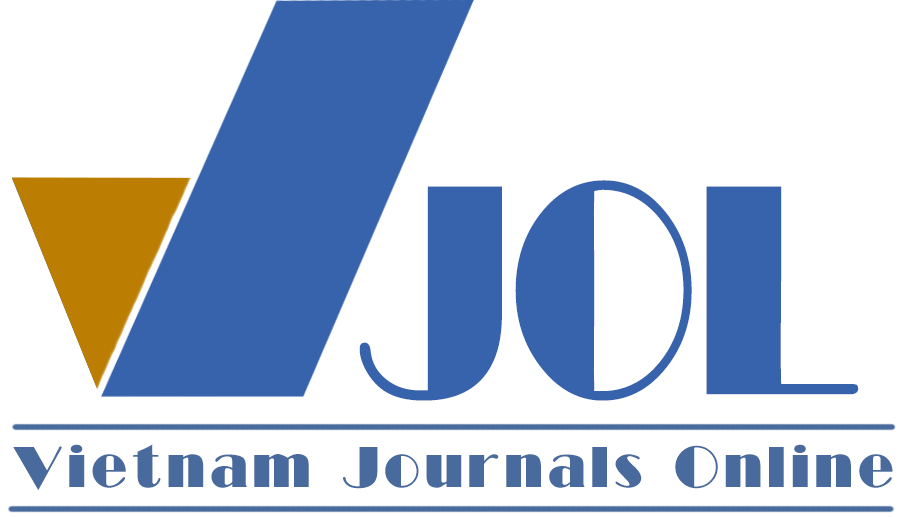Foreign direct investment and the current environmental situation: Evidence from Binh Duong, Vietnam
Authors
DOI: https://doi.org/10.57110/vnu-jeb.v5i4.340Keywords:
Foreign direct investment, environmental pollution, pollution halo, pollution haven, VietnamReferences
Abdoulie, M., & Hammami, S. (2017). Investigating the causality links between environmental quality, foreign direct investment and economic growth in MENA countries. International Business Review, 26 (2), 264-278. https://doi.org/10.1016/j.ibusrev.2016.07.004
Abid, M. (2016). Impact of economic, financial, and institutional factors on CO₂ emissions: Evidence from sub-Saharan African economies. Utilities Policy, 41, 85–94. https://doi.org/10.1016/j.jup.2016.06.009
Abid, M., Schilling, J., Scheffran, J., & Zulfiqar, F. (2016). Climate change vulnerability, adaptation and risk perceptions at the farm level in Punjab, Pakistan. Science of the Total Environment, 547, 447–460. https://doi.org/10.1016/j.scitotenv.2015.11.125
Aliyu, M. A. (2005). Foreign direct investment and the environment: Pollution haven hypothesis revisited. The 8th Annual Conference on Global Economic Analysis, Lübeck, Germany. https://ageconsearch.umn.edu/record/331376
Aliyu, M.H., Jolly, P.E., Ehiri, J.E., Salihu, H.M. (2005). High parity and adverse birth outcomes: Exploring the maze. Birth, 32(1), 45-59. https://doi.org/10.1111/j.0730-7659.2005.00344.x
An, T., Xu, C., Liao, X. (2021). The impact of FDI on environmental pollution in China: Evidence from spatial panel data. Environmental Science Pollution Research, 28, 44085-44097. https://doi.org/10.1007/s11356-021-13903-9
Antweiler, W., Copeland, B. R., & Taylor, M. S. (2001). Is free trade good for the environment? American Economic Review, 91(4), 877-908. https://doi.org/10.1257/aer.91.4.877
Asghari, M. (2013). Does FDI promote MENA region’s environment quality? Pollution halo or pollution haven hypothesis. Int J Sci Res Environ Sci, 1(6), 92-100. https://doi.org/10.12983/ijsres-2013-p092-100
Aung, T. S., Fischer, T. B., & Shengji, L. (2020). Evaluating environmental impact assessment (EIA) in the countries along the belt and road initiatives: System effectiveness and the compatibility with the Chinese EIA. Environmental Impact Assessment Review, 81, 106361. https://doi.org/10.1016/j.eiar.2019.106361Ayamba,
E. C., Haibo, C., Ibn Musah, A. A., Ruth, A., & Osei-Agyemang, A. (2019). An empirical model on the impact of foreign direct investment on China’s environmental pollution: Analysis based on simultaneous equations. Environmental Science and Pollution Research, 26, 16239-16248. https://doi.org/10.1007/s11356-019-04991-9
Binh Duong Statistics Department (2023). Socio-economic situation of Binh Duong province. Binh Duong Statistics Department, Binh Duong Province.
Binh Duong Province People's Committee (2023). Report on environmental protection work in 2023. People's Committee of Binh Duong Province.
Baharumshah, A. Z., Slesman, L., Devadason, E. S. (2017). Types of foreign capital inflows and economic growth: New Evidence on role of financial markets. Journal of International Development, 29(6), 768-789. https://doi.org/10.1002/jid.3093
Bryman, A. & Bell, E. (2011). Business Research Methods (3rd ed.). Oxford University Press. http://doi.org/10.1093/hebz/9780198869443.001.0001
Cai, Y., Chang, T., & Inglesi-Lotz, R. (2018). Asymmetric persistence in convergence for carbon dioxide emissions based on quantile unit root test with Fourier function. Energy, 161, 470-481. https://doi.org/10.1016/j.energy.2018.07.125Center for Global Development (2015). Climate change and development in three charts. https://www.cgdev.org/media/developing-countries-are-responsible-63-percent-current-carbon-emissions
Cole, M. A., Elliott, R. J., & Fredriksson, P. G. (2006). Endogenous pollution havens: Does FDI influence environmental regulations? Scandinavian Journal of Economics, 108(1), 157-178. https://doi.org/10.1111/j.1467-9442.2006.00439.x
Cole, M. A., Elliott, R. J., Zhang, L. (2017). Foreign direct investment and the environment. Annual Review of Environment and Resources, 42, 465-487. https://doi.org/10.1146/annurev-environ-102016-060916
Demena, B. A., & Afesorgbor, S. K. (2020). The effect of FDI on environmental emissions: Evidence from a meta-analysis. Energy Policy, 138, 111192. https://doi.org/10.1016/j.enpol.2019.111192
Eskeland, G. S., & Harrison, A. E. (2003). Moving to greener pastures? Multinationals and the pollution haven hypothesis. Journal of Development Economics, 70 (1), 1-23. https://doi.org/10.1016/S0304-3878(02)00084-6
Esty, D. C., & Dua, A. (1997). Sustaining the Asia Pacific Miracle: Environmental Protection and Economic Integration. Peterson Institute Press: All Books.
Golub, S. S., Kauffmann, C., & Yeres, P. (2011). Defining and measuring green FDI: An exploratory review of existing work and evidence. https://doi.org/10.1787/5kg58j1cvcvk-en
Hao, Y., Wu, Y., Wu, H., & Ren, S. (2020). How do FDI and technical innovation affect environmental quality? Evidence from China. Environmental Science and Pollution Research, 27, 7835-7850. https://doi.org/10.1007/s11356-019-07411-0
He, J. (2006). Pollution haven hypothesis and environmental impacts of foreign direct investment: The case of industrial emission of sulfur dioxide (SO2) in Chinese provinces. Ecological Economics, 60 (1), 228-245. https://doi.org/10.1016/j.ecolecon.2005.12.008
Iamsiraroj, S. (2016). The foreign direct investment–economic growth nexus. International Review of Economics & Finance, 42, 116-133. https://doi.org/10.1016/j.iref.2015.10.044
IMF (1993). Balance of Payments Manual (5th ed.). https://www.imf.org/external/pubs/ft/bopman/bopman.pdf
International Energy Agency (2018) Global energy & Co2 status report. Global Energy & CO2 Status Report, 1-15. https://www.connaissancedesenergies.org/sites/connaissancedesenergies.org/files/pdf-actualites/Global_Energy_and_CO2_Status_Report_2018.pdf
Keho, Y. (2015). Foreign direct investment, exports and economic growth: Some African evidence. Journal of Applied Economics & Business Research, 5(4). http://www.aebrjournal.org/uploads/6/6/2/2/6622240/joaebrdecember2015_209_219.pdf
Kim, Y., & Rhee, D. E. (2019). Do stringent environmental regulations attract foreign direct investment in developing countries? Evidence on the “Race to the Top” from cross-country panel data. Emerging Markets Finance and Trade, 55(12), 2796-2808. https://doi.org/10.1080/1540496X.2018.1531240
Kok, R., & Acikgoz Ersoy, B. (2009). Analyses of FDI determinants in developing countries. International Journal of Social Economics, 36 (1/2), 105-123. https://doi.org/10.1108/03068290910921226
Lan, J., Kakinaka, M., & Huang, X. (2012). Foreign direct investment, human capital and environmental pollution in China. Environmental and Resource Economics, 51, 255-275. https://doi.org/10.1007/s10640-011-9498-2
Lee, J. W. (2013). The contribution of foreign direct investment to clean energy use, carbon emissions and economic growth. Energy Policy, 55, 483-489. https://doi.org/10.1016/j.enpol.2012.12.039
Muhammad, B., & Khan, S. (2019). Effect of bilateral FDI, energy consumption, CO2 emission and capital on economic growth of Asia countries. Energy Reports, 5, 1305-1315. https://doi.org/10.1016/j.egyr.2019.09.004
Naughton, H. T. (2014). To shut down or to shift: Multinationals and environmental regulation. Ecological Economics, 102, 113-117. https://doi.org/10.1016/j.ecolecon.2014.03.013
NOAA. (2023). The Noaa Annual Greenhouse Gas Index (Aggi). https://gml.noaa.gov/aggi/aggi.html
OECD. (1996). Benchmark Definition of Foreign Direct Investment (3rd ed.). OECD Publishing. https://www.oecd.org/content/dam/oecd/en/publications/reports/1996/11/oecd-benchmark-definition-of-foreign-direct-investment_g1gh5da0/9789264064805-en.pdf
Pegkas, P. (2015). The impact of FDI on economic growth in Eurozone countries. The Journal of Economic Asymmetries, 12(2), 124-132. https://doi.org/10.1016/j.jeca.2015.05.001
Perkins, R., & Neumayer, E. (2009). Transnational linkages and the spillover of environment-efficiency into developing countries. Global Environmental Change, 19 (3), 375-383. https://doi.org/10.1016/j.gloenvcha.2009.05.003
Sattar, A., Hussain, M. N., & Ilyas, M. (2022). An impact evaluation of belt and road initiative (BRI) on environmental degradation. Sage Open, 12 (1), 21582440221078836. https://doi.org/10.1177/21582440221078836
Singhania, M., & Saini, N. (2021). Demystifying pollution haven hypothesis: Role of FDI. Journal of Business Research, 123, 516-528. https://doi.org/10.1016/j.jbusres.2020.10.007
Sitthivanh, P., & Srithilat, K. (2021). The impact of foreign direct investment on environmental quality in ASEAN countries. Journal of Resources, Energy and Development, 18 (1-2), 27-40. https://doi.org/10.3233/RED-181202
Solarin, S. A., Al-Mulali, U., Musah, I., & Ozturk, I. (2017). Investigating the pollution haven hypothesis in Ghana: An empirical investigation. Energy, 124, 706-719. https://doi.org/10.1016/j.energy.2017.02.089
Sunde, T. (2017). Foreign direct investment, exports and economic growth: ADRL and causality analysis for South Africa. Research in International Business and Finance, 41, 434-444. https://doi.org/10.1016/j.ribaf.2017.04.035
Tracy, E. F., Shvarts, E., Simonov, E., & Babenko, M. (2017). China’s new Eurasian ambitions: the environmental risks of the Silk Road Economic Belt. Eurasian Geography and Economics, 58(1), 56-88. https://doi.org/10.1080/15387216.2017.1295876
Victor, P. A. (2017). Pollution: Economy and Environment. Routledge. https://doi.org/10.4324/9781315108483
Waldkirch, A., & Gopinath, M. (2008). Pollution control and foreign direct investment in Mexico: an industry-level analysis. Environmental and Resource Economics, 41, 289-313. https://doi.org/10.1007/s10640-008-9192-1
Walter, I., & Ugelow, J. L. (1979). Environmental policies in developing countries. Ambio, 102-109. https://doi.org/10.5771/0506-7286-1981-1-95
Wang, D. T., & Chen, W. Y. (2014). Foreign direct investment, institutional development, and environmental externalities: Evidence from China. Journal of Environmental Management, 135, 81-90. https://doi.org/10.1016/j.jenvman.2014.01.013
Wang, X., & Luo, Y. (2020). Has technological innovation capability addressed environmental pollution from the dual perspective of FDI quantity and quality? Evidence from China. Journal of Cleaner Production, 258, 120941. https://doi.org/10.1016/j.jclepro.2020.120941
Wheeler, D. (2001). Racing to the bottom? Foreign investment and air pollution in developing countries. The Journal of Environment & Development, 10(3), 225-245. https://doi.org/10.1177/10704965-0101003-0
Xiao, D., Gao, L., Xu, L., Wang, Z., & Wei, W. (2023). Revisiting the green growth effect of foreign direct investment from the perspective of environmental regulation: Evidence from China. International Journal of Environmental Research and Public Health, 20(3), 2655. https://doi.org/10.3390/ijerph20032655
Yang, Q., & Song, D. (2019). How does environmental regulation break the resource curse: Theoretical and empirical study on China. Resources Policy, 64, 101480. https://doi.org/10.1016/j.resourpol.2019.101480
Yu, X., & Li, Y. (2020). Effect of environmental regulation policy tools on the quality of foreign direct investment: An empirical study of China. Journal of Cleaner Production, 270, 122346. https://doi.org/10.1016/j.jclepro.2020.122346
Zugravu-Soilita, N. (2017). How does foreign direct investment affect pollution? Toward a better understanding of the direct and conditional effects. Environmental and Resource Economics, 66, 293-338. https://doi.org/10.1007/s10640-015-9950-9
Downloads
Downloads
Published
Abstract View
PDF Downloaded
How to Cite
Issue
Section
License
Copyright (c) 2025 Nguyen Bach Dang, Pham Thi Hong Nhung, Phan Thi Nga

This work is licensed under a Creative Commons Attribution-NonCommercial 4.0 International License.
by VNU Journal of Economics and Business






